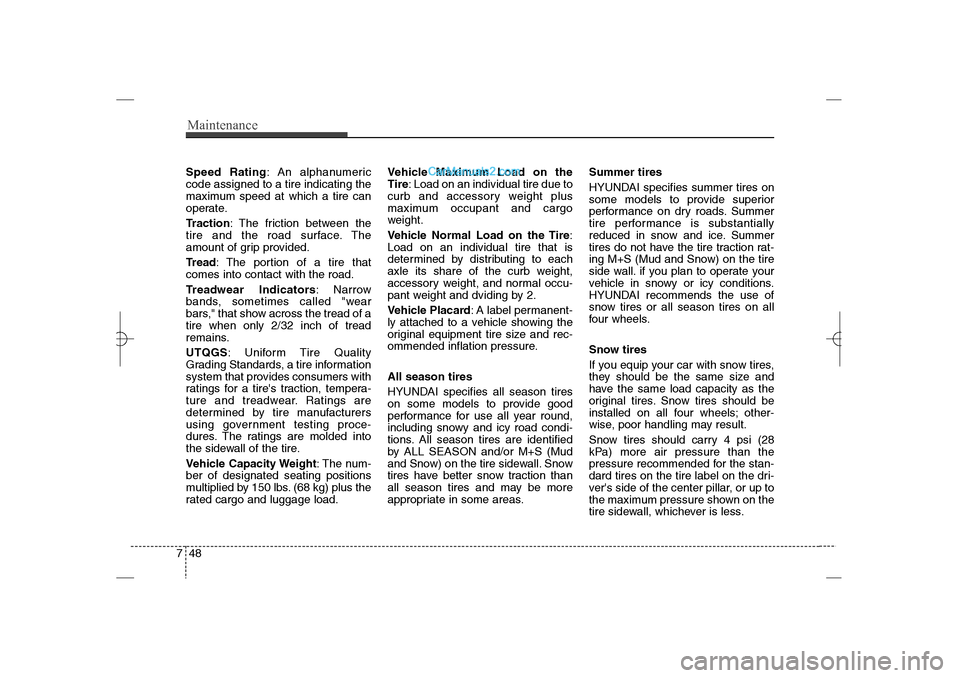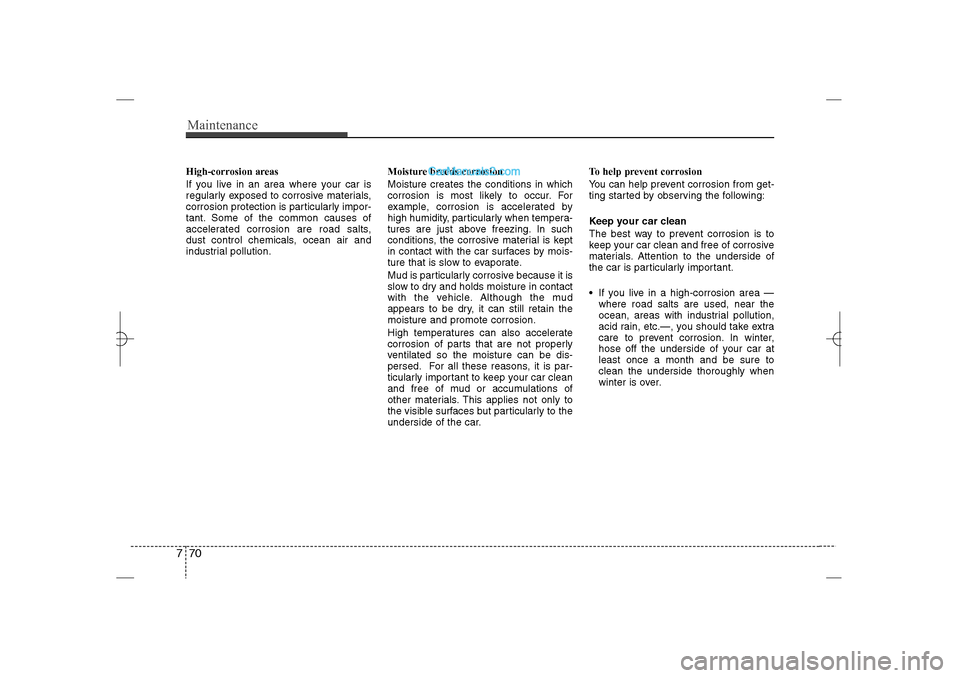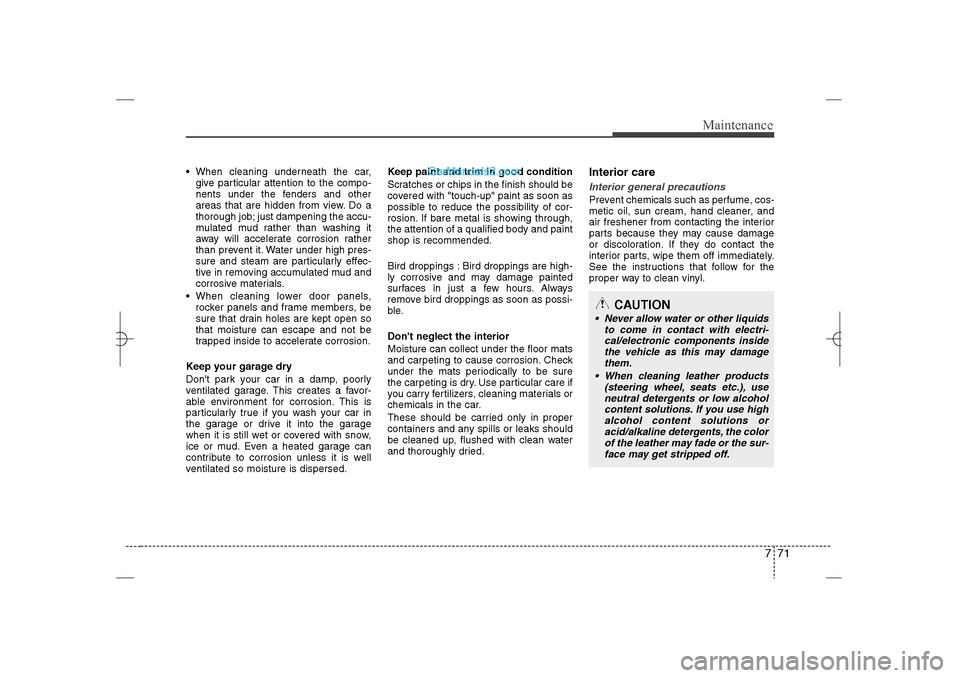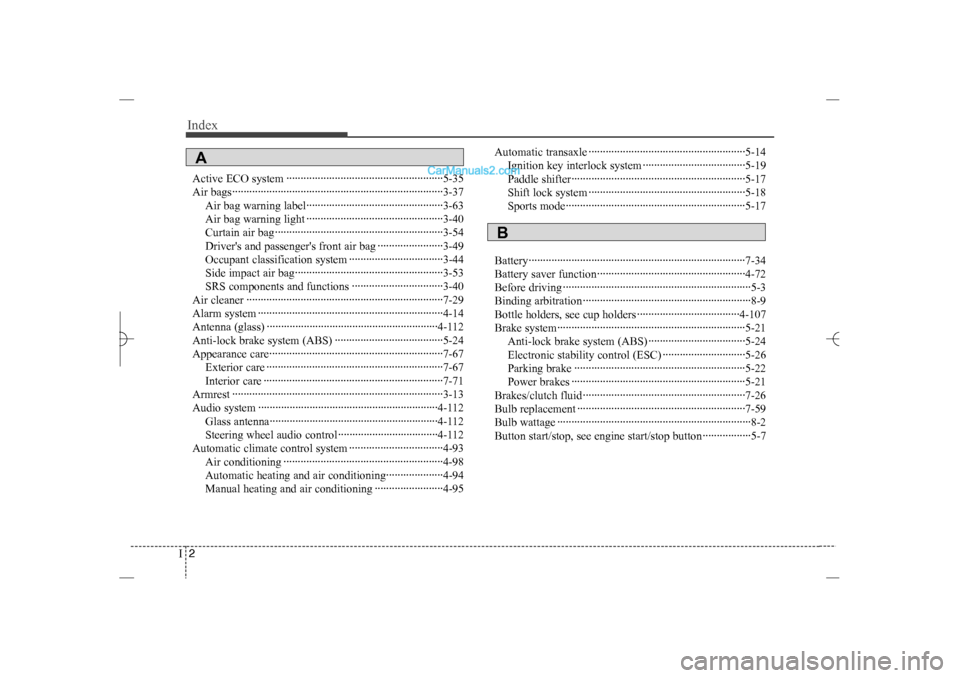2013 Hyundai Sonata air condition
[x] Cancel search: air conditionPage 360 of 410

745
Maintenance
5. Maximum permissible inflation
pressureThis number is the greatest amount
of air pressure that should be put in
the tire. Do not exceed the maximum
permissible inflation pressure. Refer
to the Tire and Loading Information
label for recommended inflation
pressure.6. Maximum load ratingThis number indicates the maximum
load in kilograms and pounds that
can be carried by the tire. When
replacing the tires on the vehicle,
always use a tire that has the same
load rating as the factory installed
tire.
7. Uniform tire quality grading Quality grades can be found where
applicable on the tire sidewall
between tread shoulder and maxi-
mum section width.
For example: TREAD wear 200
TRACTION AA
TEMPERATURE ATread wearThe tread wear grade is a compara-
tive rating based on the wear rate of
the tire when tested under controlled
conditions on a specified govern-
ment test course. For example, a tire
graded 150 would wear one-and-a-
half times (1½) as well on the gov-
ernment course as a tire graded 100.
The relative performance of tires
depends upon the actual conditions
of their use, however, and may
depart significantly from the norm
due to variations in driving habits,
service practices and differences in
road characteristics and climate.
These grades are molded on the
side-walls of passenger vehicle tires.
The tires available as standard or
optional equipment on your vehicle
may vary with respect to grade.
Traction - AA, A, B & C The traction grades, from highest to
lowest, are AA, A, B and C. Those
grades represent the tire’s ability to
stop on wet pavement as measured
under controlled conditions on spec-
ified government test surfaces of
asphalt and concrete. A tire marked
C may have poor traction perform-
ance.
WARNING
The traction grade assigned to
this tire is based on straight-
ahead braking traction tests,
and does not include accelera-
tion, cornering, hydroplaning,
or peak traction characteristics.
YF HMA 7.qxp 1/16/2012 6:19 PM Page 45
Page 363 of 410

Maintenance48 7Speed Rating: An alphanumeric
code assigned to a tire indicating the
maximum speed at which a tire can
operate.
Traction: The friction between the
tire and the road surface. The
amount of grip provided.
Tread: The portion of a tire that
comes into contact with the road.
Treadwear Indicators: Narrow
bands, sometimes called "wear
bars," that show across the tread of a
tire when only 2/32 inch of tread
remains.
UTQGS: Uniform Tire Quality
Grading Standards, a tire information
system that provides consumers with
ratings for a tire's traction, tempera-
ture and treadwear. Ratings are
determined by tire manufacturers
using government testing proce-
dures. The ratings are molded into
the sidewall of the tire.
Vehicle Capacity Weight: The num-
ber of designated seating positions
multiplied by 150 lbs. (68 kg) plus the
rated cargo and luggage load.Vehicle Maximum Load on the
Tire: Load on an individual tire due to
curb and accessory weight plus
maximum occupant and cargo
weight.
Vehicle Normal Load on the Tire:
Load on an individual tire that is
determined by distributing to each
axle its share of the curb weight,
accessory weight, and normal occu-
pant weight and dviding by 2.
Vehicle Placard: A label permanent-
ly attached to a vehicle showing the
original equipment tire size and rec-
ommended inflation pressure.
All season tires
HYUNDAI specifies all season tires
on some models to provide good
performance for use all year round,
including snowy and icy road condi-
tions. All season tires are identified
by ALL SEASON and/or M+S (Mud
and Snow) on the tire sidewall. Snow
tires have better snow traction than
all season tires and may be more
appropriate in some areas.Summer tires
HYUNDAI specifies summer tires on
some models to provide superior
performance on dry roads. Summer
tire performance is substantially
reduced in snow and ice. Summer
tires do not have the tire traction rat-
ing M+S (Mud and Snow) on the tire
side wall. if you plan to operate your
vehicle in snowy or icy conditions.
HYUNDAI recommends the use of
snow tires or all season tires on all
four wheels.
Snow tires
If you equip your car with snow tires,
they should be the same size and
have the same load capacity as the
original tires. Snow tires should be
installed on all four wheels; other-
wise, poor handling may result.
Snow tires should carry 4 psi (28
kPa) more air pressure than the
pressure recommended for the stan-
dard tires on the tire label on the dri-
ver's side of the center pillar, or up to
the maximum pressure shown on the
tire sidewall, whichever is less.
YF HMA 7.qxp 1/16/2012 6:19 PM Page 48
Page 385 of 410

Maintenance70 7High-corrosion areas
If you live in an area where your car is
regularly exposed to corrosive materials,
corrosion protection is particularly impor-
tant. Some of the common causes of
accelerated corrosion are road salts,
dust control chemicals, ocean air and
industrial pollution.Moisture breeds corrosion
Moisture creates the conditions in which
corrosion is most likely to occur. For
example, corrosion is accelerated by
high humidity, particularly when tempera-
tures are just above freezing. In such
conditions, the corrosive material is kept
in contact with the car surfaces by mois-
ture that is slow to evaporate.
Mud is particularly corrosive because it is
slow to dry and holds moisture in contact
with the vehicle. Although the mud
appears to be dry, it can still retain the
moisture and promote corrosion.
High temperatures can also accelerate
corrosion of parts that are not properly
ventilated so the moisture can be dis-
persed. For all these reasons, it is par-
ticularly important to keep your car clean
and free of mud or accumulations of
other materials. This applies not only to
the visible surfaces but particularly to the
underside of the car.To help prevent corrosion
You can help prevent corrosion from get-
ting started by observing the following:
Keep your car clean
The best way to prevent corrosion is to
keep your car clean and free of corrosive
materials. Attention to the underside of
the car is particularly important.
If you live in a high-corrosion area —
where road salts are used, near the
ocean, areas with industrial pollution,
acid rain, etc.—, you should take extra
care to prevent corrosion. In winter,
hose off the underside of your car at
least once a month and be sure to
clean the underside thoroughly when
winter is over.
YF HMA 7.qxp 1/16/2012 6:21 PM Page 70
Page 386 of 410

771
Maintenance
When cleaning underneath the car,
give particular attention to the compo-
nents under the fenders and other
areas that are hidden from view. Do a
thorough job; just dampening the accu-
mulated mud rather than washing it
away will accelerate corrosion rather
than prevent it. Water under high pres-
sure and steam are particularly effec-
tive in removing accumulated mud and
corrosive materials.
When cleaning lower door panels,
rocker panels and frame members, be
sure that drain holes are kept open so
that moisture can escape and not be
trapped inside to accelerate corrosion.
Keep your garage dry
Don't park your car in a damp, poorly
ventilated garage. This creates a favor-
able environment for corrosion. This is
particularly true if you wash your car in
the garage or drive it into the garage
when it is still wet or covered with snow,
ice or mud. Even a heated garage can
contribute to corrosion unless it is well
ventilated so moisture is dispersed.Keep paint and trim in good condition
Scratches or chips in the finish should be
covered with "touch-up" paint as soon as
possible to reduce the possibility of cor-
rosion. If bare metal is showing through,
the attention of a qualified body and paint
shop is recommended.
Bird droppings : Bird droppings are high-
ly corrosive and may damage painted
surfaces in just a few hours. Always
remove bird droppings as soon as possi-
ble.
Don't neglect the interior
Moisture can collect under the floor mats
and carpeting to cause corrosion. Check
under the mats periodically to be sure
the carpeting is dry. Use particular care if
you carry fertilizers, cleaning materials or
chemicals in the car.
These should be carried only in proper
containers and any spills or leaks should
be cleaned up, flushed with clean water
and thoroughly dried.
Interior careInterior general precautions Prevent chemicals such as perfume, cos-
metic oil, sun cream, hand cleaner, and
air freshener from contacting the interior
parts because they may cause damage
or discoloration. If they do contact the
interior parts, wipe them off immediately.
See the instructions that follow for the
proper way to clean vinyl.
CAUTION
Never allow water or other liquids
to come in contact with electri-
cal/electronic components inside
the vehicle as this may damage
them.
When cleaning leather products
(steering wheel, seats etc.), use
neutral detergents or low alcohol
content solutions. If you use high
alcohol content solutions or
acid/alkaline detergents, the color
of the leather may fade or the sur-
face may get stripped off.
YF HMA 7.qxp 1/16/2012 6:21 PM Page 71
Page 390 of 410

775
Maintenance
Do not operate the engine in confined
or closed areas (such as garages) any
more than what is necessary to move
the vehicle in or out of the area.
When the vehicle is stopped in an
open area for more than a short time
with the engine running, adjust the
ventilation system (as needed) to draw
outside air into the vehicle.
Never sit in a parked or stopped vehi-
cle for any extended time with the
engine running. When the engine stalls or fails to start,
excessive attempts to restart the
engine may cause damage to the
emission control system.
Operating precautions for catalytic
converters (if equipped)
Your vehicle is equipped with a catalytic
converter emission control device.
Therefore, the following precautions
must be observed:
Use only UNLEADED FUEL for gaso-
line engines.
Do not operate the vehicle when there
are signs of engine malfunction, such
as misfire or a noticeable loss of per-
formance.
Do not misuse or abuse the engine.
Examples of misuse are coasting with
the ignition off and descending steep
grades in gear with the ignition off.
Do not operate the engine at high idle
speed for extended periods (5 minutes
or more).
Do not modify or tamper with any part
of the engine or emission control sys-
tem. All inspections and adjustments
must be made by an authorized
HYUNDAI dealer.
Avoid driving with a extremely low fuel
level. Running out of fuel could cause
the engine to misfire, damaging the
catalytic converter.
Failure to observe these precautions
could result in damage to the catalytic
converter and to your vehicle.
Additionally, such actions could void your
warranties.
CALIFORNIA PROPOSI-
TION 65 WARNING
Engine exhaust and a wide variety
of automobile components and
parts, including components found
in the interior furnishings in a vehi-
cle, contain or emit chemicals
known to the State of California to
cause cancer and birth defects and
reproductive harm. In addition, cer-
tain fluids contained in vehicles
and certain products of component
wear contain or emit chemicals
known to the State of California to
cause cancer and birth defects or
other reproductive harm.
WARNING
- Fire
A hot exhaust system can ignite
flammable items under your vehi-
cle. Do not park, idle, or drive the
vehicle over or near flammable
objects, such as grass, vegeta-
tion, paper, leaves, etc.
The exhaust system and catalytic
system are very hot while the
engine is running or immediately
after the engine is turned off. Keep
away from the exhaust system
and catalytic, you may get burned.
Also, do not remove the heat sink
around the exhaust system, do
not seal the bottom of the vehicle
or do not coat the vehicle for cor-
rosion control. It may present a
fire risk under certain conditions.
YF HMA 7.qxp 1/16/2012 6:21 PM Page 75
Page 402 of 410

Index2I
Active ECO system ·······················································5-35
Air bags··········································································3-37
Air bag warning label················································3-63
Air bag warning light ················································3-40
Curtain air bag···························································3-54
Driver's and passenger's front air bag ·······················3-49
Occupant classification system ·································3-44
Side impact air bag····················································3-53
SRS components and functions ································3-40
Air cleaner ·····································································7-29
Alarm system ·································································4-14
Antenna (glass) ····························································4-112
Anti-lock brake system (ABS) ······································5-24
Appearance care·····························································7-67
Exterior care ······························································7-67
Interior care ·······························································7-71
Armrest ··········································································3-13
Audio system ·······························································4-112
Glass antenna···························································4-112
Steering wheel audio control···································4-112
Automatic climate control system ·································4-93
Air conditioning ························································4-98
Automatic heating and air conditioning····················4-94
Manual heating and air conditioning ························4-95Automatic transaxle ·······················································5-14
Ignition key interlock system ····································5-19
Paddle shifter·····························································5-17
Shift lock system ·······················································5-18
Sports mode·······························································5-17
Battery············································································7-34
Battery saver function····················································4-72
Before driving ··································································5-3
Binding arbitration ···························································8-9
Bottle holders, see cup holders ····································4-107
Brake system··································································5-21
Anti-lock brake system (ABS) ··································5-24
Electronic stability control (ESC) ·····························5-26
Parking brake ····························································5-22
Power brakes ·····························································5-21
Brakes/clutch fluid ·························································7-26
Bulb replacement ···························································7-59
Bulb wattage ····································································8-2
Button start/stop, see engine start/stop button·················5-7A
B
YF HMA INDEX.QXP 5/16/2011 5:52 PM Page 2
Page 403 of 410

I3
Index
California perchlorate notice ·········································7-76
Capacities (Lubricants) ····················································8-4
Care
Exterior care ······························································7-67
Interior care ·······························································7-71
Tire care·····································································7-37
Cargo weight ··································································5-51
Center console storage ·················································4-105
Central door lock switch················································4-19
Certification label ···················································5-49, 8-6
Changing tires ································································6-13
Chains
Tire chains ·································································5-43
Checking tire inflation pressure·····································7-38
Child restraint system ····················································3-29
Passenger seat belt ····················································3-31
Tether anchor system·················································3-33
Lower anchor system ················································3-35
Child-protector rear door lock ·······································4-21
Climate control system (Automatic) ·····························4-97
Air conditioning ······················································4-100
Automatic heating and air conditioning····················4-94
Manual heating and air conditioning ························4-95
Climate control system (Manual) ··································4-83
Air conditioning ························································4-90
Climate control air filter············································4-92
Heating and air conditioning·····································4-84Climate control air filter ················································4-94
Climate control air filter ················································7-30
Clock (Digital) ·····························································4-109
Clothes hanger ·····························································4-109
Combined instrument, see instrument cluster ···············4-50
Compact spare tire ·························································6-18
Compact spare tire replacement ····································7-42
Compass mirror, see the Electric chromic mirror (ECM)
with homeLink system and compass ························4-41
Consumer information ·····················································8-8
Coolant ···········································································7-24
Cooling fluid, see engine coolant ··································7-24
Crankcase emission control system ·······························7-73
Cruise control system ····················································5-31
Cup holder ···································································4-107
Curtain air bag ·······························································3-54
Dashboard, see instrument cluster ·································4-50
Dashboard illumination, see instrument panel
illumination ·······························································4-51
Daytime running light····················································4-73
Defogging (Windshield) ··············································4-101
Defogging logic (Windshield) ·····································4-103
Defroster (Rear window) ···············································4-82
Defrosting (Windshield) ··············································4-101
Digital clock·································································4-109
Dimensions ······································································8-2C
D
YF HMA INDEX.QXP 5/16/2011 5:52 PM Page 3
Page 407 of 410

I7
Index
Maintenance
Explanation of scheduled maintenance items ···········7-19
Maintenance services ··················································7-4
Maintenance under severe usage conditions ·············7-18
Normal maintenance schedule ····································7-8
Owner maintenance·····················································7-5
Scheduled maintenance service ··································7-7
Tire maintenance ·······················································7-42
Maintenance services ·······················································7-4
Manual climate control system······································4-83
Air conditioning ························································4-89
Climate control air filter············································4-92
Heating and air conditioning·····································4-84
Manual transaxle ····························································5-11
Memory fuse ··································································7-52
Mirrors ···········································································4-41
Day/night rearview mirror ········································4-41
Electric chromic mirror (ECM) with Homelink system
and compass ····························································4-41
Inside rearview mirror···············································4-41
Outside rearview mirror ············································4-48
Moonroof, see sunroof ·········································4-32, 4-35
Multi box ·····································································4-106
Multi fuse ·······································································7-53Neck restraints, see headrest ··································3-7, 3-11
Occupant classification system······································3-44
Odometer ·······································································4-54
Oil (Engine) ···································································7-22
Outside rearview mirror·················································4-48
Overheats ·········································································6-6
Owner maintenance ·························································7-5
Paddle shifter ·································································5-17
Panorama sunroof ··························································4-35
Parking brake inspect·····················································7-28
Parking brake ·································································5-22
Passenger's front air bag ················································3-49
Power brakes··································································5-21
Power outlet ·································································4-108
Power window lock button ············································4-27
Pre-tensioner seat belt····················································3-23
Push starting·····································································6-5M
NOP
YF HMA INDEX.QXP 5/16/2011 5:52 PM Page 7